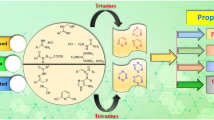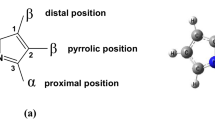Abstract
Four xanthenyl-derived host compounds, namely trans-N,N′-bis(9-phenyl-9-xanthenyl)cyclohexane-1,4-diamine (1,4-DAX), trans-N,N′-bis(9-phenyl-9-thioxanthenyl)cyclohexane-1,4-diamine (1,4-DAT), N,N′-bis(9-cyclohexyl-9-xanthenyl)ethylenediamine (OED) and N,N′-bis(9-cyclohexyl-9-thioxanthenyl)ethylenediamine (SED) were assessed for their selectivity behaviour in the presence of both the saturated and unsaturated heterocyclic six-membered ring guest solvents morpholine (MOR), piperidine (PIP), dioxane (DIO) and pyridine (PYR). Related compounds OED and SED behaved similarly when each was recrystallized from mixtures of these guests, both selecting for MOR and discriminating against PYR, while, surprisingly, the performance of structurally-similar 1,4-DAX and 1,4-DAT in equivalent conditions, on the other hand, was entirely contrasting: only 1,4-DAX formed complexes from such guest mixtures and 1,4-DAT failed to do so in each instance. Furthermore, 1,4-DAX preferred PYR, an observation distinct from that of OED and SED. Single crystal diffraction (SCXRD) experiments were carried out on suitable crystals formed by 1,4-DAX with these guests, and it was revealed that the preference for PYR may be attributed to both host–guest π–π interactions and a shorter H-bond between molecules of the host and PYR compared with other complexes. SCXRD experiments were not possible for OED, SED and 1,4-DAT owing to either the inability of the host compound to complex with these guests or poor crystal quality of the resultant complexes.







Similar content being viewed by others
References
https://www.sciencedirect.com. Accessed 29 Oct 2019
Kuhn, R., Erni, F., Bereuter, T., Haeusler, J.: Chiral recognition and enantiomeric resolution based on host-guest complexation with crown ethers in capillary zone electrophoresis. J. Anal. Chem. 64, 2815–2820 (1992)
Caira, M.R., Bourne, S.A., Samsodien, H., Smith, V.: Inclusion complexes of 2-methoxyestradiol with dimethylated and permethylated β-cyclodextrins: models for cyclodextrin-steroid interaction. J. Beilstein J. Org. Chem. 11, 2616–2630 (2015)
Saleh, N., Khaleel, A., Al-Dmour, H., Al-Hindawi, B., Yakushenko, E.: Host–guest complexes of cucurbit [7] uril with albendazole in solid state. J. Therm. Anal. Calorim. 111, 385–392 (2013)
Gao, Z.-Z., Bai, D., Xiao, Z.-Y., Zhu, Q.-J., Xue, S.-F., Tao, Z., Xiao, X.: Host–guest interactions in tetramethyl-cucurbit [6] uril with anti-tuberculosis drug isoniazid. Inorg. Chem. Commun. 71, 68–72 (2016)
Patel, L.D., Separation of isomers by enclathration, MSc dissertation: 2014, Cape Peninsula University of Technology
Sholl, D.S., Lively, R.P.: Seven chemical separations to change the world. Nature 532, 435–437 (2016)
Lusi, M., Barbour, L.J.: Solid–vapor sorption of xylenes: prioritized selectivity as a means of separating all three isomers using a single substrate. Angew. Chem. Int. Ed. 51, 3928–3931 (2012)
Pyka, I., Ryvlin, D., Waldvogel, S.R.: Application of rigidity-controlled supramolecular affinity materials for the gravimetric detection of hazardous and illicit compounds. ChemPlusChem 81, 926–929 (2016)
Dickert, F.L., Haunschild, A.: Sensor materials for solvent vapor detection—donor–acceptor and host–guest interactions. Adv. Mater. 5, 887–895 (1993)
Hughes, E., Jordan, J., Gullion, T.: Structural characterization of the [Cs(p-tert-butylcalix[4]arene−H)(MeCN)] guest−host system by 13C–133Cs REDOR NMR. J. Phys. Chem. B 105, 5887–5891 (2001)
Erdemir, S., Bahadir, M., Yilmaz, M.: Extraction of carcinogenic aromatic amines from aqueous solution using calix[n]arene derivatives as carrier. J. Hazard. Mater. 168, 1170–1176 (2009)
Szente, L., Szejtli, J.: Cyclodextrins as food ingredients. Trends Food Sci. Technol. 15, 137–142 (2004)
Sousa, L.R., Sogah, G., Hoffman, D.H., Cram, D.J.: Host–guest complexation. 12. Total optical resolution of amine and amino ester salts by chromatography. J. Am. Chem. Soc. 100, 4569–4576 (1978)
Wang, W., Bray, C.L., Adams, D.J., Cooper, A.I.: Methane storage in dry water gas hydrates. J. Am. Chem. Soc. 130, 11608–11609 (2008)
Kumar, R., Linga, P., Moudrakovski, I., Ripmeester, J.A., Englezos, P.: Structure and kinetics of gas hydrates from methane/ethane/propane mixtures relevant to the design of natural gas hydrate storage and transport facilities. AIChE J. 54, 2132–2144 (2008)
Lee, H., Lee, J.-W., Park, J., Seo, Y.-T., Zeng, H., Moudrakovski, I.L., Ratcliffe, C.I., Ripmeester, J.A.: Tuning clathrate hydrates for hydrogen storage. Nature 434, 743–746 (2005)
Arjmandi, M., Chapoy, A., Tohidi, B.: Equilibrium data of hydrogen, methane, nitrogen, carbon dioxide, and natural gas in semi-clathrate hydrates of tetrabutyl ammonium bromide. J. Chem. Eng. Data 52, 2153–2158 (2007)
Bai, C.C., Tian, B.R., Zhao, T., Huang, Q., Wang, Z.Z.: Cyclodextrin-catalyzed organic synthesis: reactions, mechanisms, and applications. Molecules 22, 1475/1–1475/17 (2017)
Drabowicz, J., Mikołajczyk, M.: Asymmetric oxidation of sulfides to sulfoxides catalyzed by β-cyclodextrin. Phosphorus Sulfur Rel. Elem. 21, 245–248 (1984)
Czarnik, A.W.: Cyclodextrin-mediated chiral sulfoxidations. J. Org. Chem. 49, 924–927 (1984)
Shen, H.-M., Ji, H.-B.: Amino alcohol-modified β-cyclodextrin inducing biomimetic asymmetric oxidation of thioanisole in water. Carbohydr. Res. 354, 49–58 (2012)
Park, K.K., Sim, W.-J., Park, J.W.: Asymmetric induction by β-cyclodextrins in NaBH4 reduction of ketones. J. Incl. Phenom. Macrocycl. Chem. 27, 41–48 (1997)
Barton, B., Jooste, D.V., Hosten, E.C.: Synthesis and assessment of compounds trans-N,N'-bis(9-phenyl-9-xanthenyl)cyclohexane-1,4-diamine and trans-N,N'-bis(9-phenyl-9-thioxanthenyl)cyclohexane-1,4-diamine as hosts for potential xylene and ethylbenzene guests. J. Incl. Phenom. Macrocycl. Chem. 93, 333–346 (2019)
Barton, B., Senekal, U., Hosten, E.C.: Compounds N,N′-bis(9-cyclohexyl-9-xanthenyl)ethylenediamine and its thio derivative, N,N′-bis(9-cyclohexyl-9-thioxanthenyl)ethylenediamine, as potential hosts in the presence of xylenes and ethylbenzene: conformational analyses and molecular modelling considerations. Tetrahedron 75, 3399–3412 (2019)
Barton, B., de Jager, L., Senekal, S., Hosten, E.C.: Comparing the effect of selected substituent changes on host ability and selectivity in four xanthenyl-type host compounds in the presence of cyclohexanone and methylcyclohexanone isomers. J. Incl. Phenom. Macrocycl. Chem. 95, 259–271 (2019)
Senekal, U., Barton, B., Hosten, E.C.: Inclusion ability and selectivity of ethylenediamine derivatives for pyridine in the presence of methylpyridine isomers. J. Incl. Phenom. Macrocycl. Chem. 96, 251–262 (2020)
Bruker, A.X.S.: APEX2, SADABS and SAINT. Bruker, A.X.S., Madison, WI (2010)
Sheldrick, G.M.: SHELXT-integrated space-group and crystal structure determination. Acta Crystallogr. A 71, 3 (2015)
Sheldrick, G.M.: Crystal structure refinement with SHELXL. Acta Crystallogr. C 71, 3 (2015)
Hübschle, C.B., Sheldrick, G.M., Dittrich, B.: ShelXle: a Qt graphical user interface for SHELXL. J. Appl. Crystallogr. 44, 1281 (2011)
Senekal, U., Barton, B., Hosten, E.C.: Inclusion ability and selectivity of ethylenediamine derivatives for pyridine in the presence of methylpyridine isomers. J. Incl. Phenom. Macrocycl. Chem. (2019). https://doi.org/10.1007/s10847-019-00966-y
Mercury 3.10.2 (Build 189770), https://www.ccdc.cam.ac.uk/mercury/. Accessed Dec 2019.
Pivovar, A.M., Holman, K.T., Ward, M.D.: Shape-selective separation of molecular isomers with tunable hydrogen-bonded host frameworks. Chem. Mater. 13, 3018–3031 (2001)
Barton, B., Dorfling, S.-L., Hosten, E.C.: Cyclohexanone-driven discriminatory behaviour change of host compound (+)-(2R,3R)-TETROL for the isomeric methylcyclohexanone guests. Cryst. Growth Des. 17, 6725–6732 (2017)
Acknowledgements
Financial support is acknowledged from the Nelson Mandela University and the National Research Foundation (NRF).
Author information
Authors and Affiliations
Corresponding author
Additional information
Publisher's Note
Springer Nature remains neutral with regard to jurisdictional claims in published maps and institutional affiliations.
Electronic supplementary material
The crystallographic data for all complexes where suitable crystal quality was obtained were deposited at the Cambridge Crystallographic Data Centre {CCDC-1964563 [1,4-DAX•2(PYR)], 1964564 [1,4-DAX•2(DIO)], 1964565 [1,4-DAX•2(MOR)], 1964566 [1,4-DAX•2(PIP)], 1964567 [1,4-DAT•2(DIO)], 1918458 (OED•PYR) and 1918461 (SED•PYR). These data may be obtained free of charge via www.ccdc.cam.ac.uk/data_request/cif. A comprehensive table displaying the H⋯G and G⋯G interactions is provided in Table S1, and additional figures illustrating the classical intermolecular H-bonding interactions between 1,4-DAX and PIP (Figure S1a) and MOR (Figure S1b) may also be found here. Below is the link to the electronic supplementary material.
Rights and permissions
About this article
Cite this article
Barton, B., Jooste, D.V., Senekal, U. et al. Four xanthenyl-derived compounds: a comparative investigation of their host behaviour in the presence potential saturated and unsaturated heterocyclic six-membered ring guest solvents. J Incl Phenom Macrocycl Chem 97, 217–229 (2020). https://doi.org/10.1007/s10847-020-00997-w
Received:
Accepted:
Published:
Issue Date:
DOI: https://doi.org/10.1007/s10847-020-00997-w




